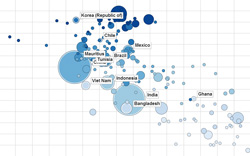-
Demographic Dividend and the Rise of the Global South
March 15, 2013 By Meaghan Parker
The Global South is “radically reshaping the world of the 21st century, with developing nations driving economic growth, lifting hundreds of millions of people from poverty, and propelling billions more into a new global middle class,” says the United Nations Development Program’s (UNDP) 2013 Human Development Report, released yesterday. “More than 40 developing countries have made greater human development gains in recent decades than would have been predicted.”
The Global South is “radically reshaping the world of the 21st century, with developing nations driving economic growth, lifting hundreds of millions of people from poverty, and propelling billions more into a new global middle class,” says the United Nations Development Program’s (UNDP) 2013 Human Development Report, released yesterday. “More than 40 developing countries have made greater human development gains in recent decades than would have been predicted.”
Some of these countries are realizing the “demographic dividend” – a period of economic growth that can occur when changes in a population’s age structure lower the country’s dependency ratio (the ratio of children and older people to the working-age population) and policies are in place to take advantage of it.
Watch as the Human Development Index rises as dependency ratios fall in this infographic using new data from the report.
“Some poorer countries will benefit from a demographic dividend as the share of the population in the workforce rises,” the report says. But it also warns that many countries “have only a brief window of opportunity to reap the full benefits of the demographic dividend of a larger working-age population.”
To do so, UNDP urges “strong policy action,” particularly in support of girls’ education. “Educated women tend to have fewer, healthier, and better educated children; in many countries educated women also enjoy higher salaries than do uneducated workers.”
Sources: United Nations Development Program.
Chart Credit: Google Public Data Explorer.
 A Publication of the Stimson Center.
A Publication of the Stimson Center.




